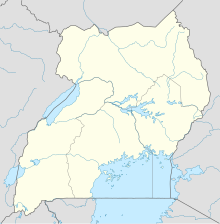Bujagali
Coordinates: 0 ° 29 ′ 56 ″ N , 33 ° 8 ′ 24 ″ E
Bujagali ( Budhagali on Lusoga that the people of the Basoga in the Kingdom of Busoga spoken language) were named rapids at Jinja in Uganda , near the spot where the Nile to Lake Victoria leaves. The rapids (English Bujagali Falls ) got their name after a family that was responsible for the rapids and the holy places surrounding them from ancient times. On February 2, 2012, the first of five turbines to generate electricity at the downstream Bujagali Dam went into operation, and the waterfalls have disappeared since it was flooded, which began in late 2011.
Bujagali Falls
The Bujagali Falls were at an altitude of 1143 meters. They were part of a series of waterfalls, rapids and cataracts that the Victoria Nile has to overcome on its course before it flows into Lake Albert via Lake Kyoga in the north and then leaves it again as the Albert Nile.
Immediately at the point where the Victoria Nile pours out of Lake Victoria and which is still traditionally called the Source of the Nile , even if over 1000 kilometers of the river's course are suppressed, these were once the Ripon Falls , theirs Explorer John Hanning Speke so named after the then President of the Royal Geographical Society , as well as the Owen Falls. With the completion of the Owen Falls Dam in 1954, however, both waterfalls sank into Lake Victoria .
The Bujagali Falls began about eight kilometers downstream from Jinja and consisted of a series of five rapids stretching over six kilometers. In the last few years before the flooding, a number of tourist opportunities were created in the area around the rapids, including hotels and campsites in particular white water rafting.
In Uganda, which had no fossil fuels for a long time, all waterfalls came early into the focus of the economy and the authorities responsible for the country's energy supply. The Murchison Falls further north of the country offer by far the greatest potential with more than 600 MW , as studies carried out during colonial times and plans drawn up accordingly show. However, because they were included in the UNESCO natural heritage in the 1990s and are also located in one of the country's most important national parks as a potential source of foreign exchange, they are protected from industrial use for the foreseeable future.
Bujagali dam
The construction of the Bujagali dam and the associated 250 - megawatt - power plant has been one of the most controversial development projects worldwide. Its proponents emphasize that the project is indispensable in view of the high growth rates of the Ugandan economy on the one hand and permanent power outages and a current power deficit of 120 megawatts on the other. Project opponents, especially from western countries, point out, however, that the project sum is completely overpriced - not least due to corruption and the overriding of all international customs for project awards of this magnitude. This would waste national resources and international aid. Furthermore, the project is economically pointless due to possible alternatives and also because of the completely inadequate infrastructure for the distribution of electricity, and the environment of this region, which is one of the most beautiful in Uganda, would suffer irreparable damage.
Financing plan
The first steps towards the realization of the project go back to 1994, when there was still no talk of the Kyoto Protocol and emission rights. In 2000, the contract was initially awarded to a joint venture between the US AES Corporation and the Ugandan Madhvani Group. Funds established, inter alia, a subsidiary of the World Bank and the for KfW owned German Investment and Development Company (DEG) ready. However, in the course of corruption investigations against the Ugandan partner and the withdrawal of AES in the wake of the Enron scandal, the project, the completion of which was planned for 2005, came to a temporary standstill.
execution
In December 2005, a purchase agreement for electrical energy was signed between the Ugandan Ministry of Energy and the private development company Bujagali Energy Ltd under the leadership of Industrial Promotions Services (IPS), whose majority shareholder is Karim Aga through its Aga Khan Fund for Economic Development (AKFED) based in Geneva Khan IV is. IPS takes over the project from AES Nile Independent Power. The project work is to begin in July 2006 at Dumbbell Island, an island in the Nile near Bujagali.
At a press conference on the construction site in early January 2011, construction manager Keneth Kaheru reported that the capacity will be 250 megawatts: “The work on the first unit is almost complete. At the end of the year, three units would have to be accepted and approved, which then produce electricity. ”According to this, the reservoir only has to be filled once at the beginning, then no more water is used:“ Nothing is lost. We use the water that comes in to generate electricity. Then it flows out again 100 percent. "
The turbines began commercial operation in August 2012. According to Thomas DeLeo, the technical director of the company Sithe Global involved, the estimated 250 megawatts of electricity are generated at least four hours a day. In the first year after completion, electricity production in the entire country rose by 44 percent.
Individual evidence
- ↑ Uganda adds 50MW from Bujagali dam to tackle power cuts. Reuters, February 2, 2012
- ↑ Antje Diekhans: Uganda relies on hydropower. (mp3) tagesschau.de archive, January 5, 2011, accessed on September 21, 2013 .
- ↑ Shifa Mwesigye: Uganda: One Year On - Bujagali Doubles Power Supply. allAfrica, August 8, 2013

